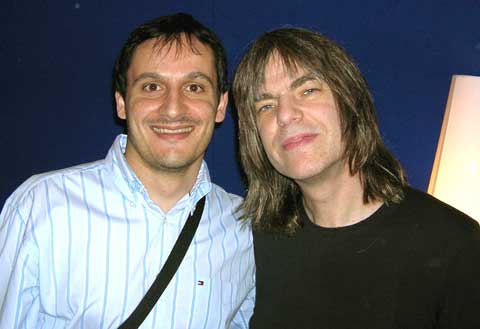Decima puntata della rubrica che vede Daniele Bazzani e Giovanni Onofri parlare delle...

 After this brief introduction, Mike Stern led the audience through an analysis of his own music, performing their own songs alternating with moments of discourse and analysis.
After this brief introduction, Mike Stern led the audience through an analysis of his own music, performing their own songs alternating with moments of discourse and analysis.
Like a perfect student I attended the sold out seminar at the Accademia del Suono in Milan, armed with manuscript paper and pencil to try and note down some precious tips.
The topics covered were:
1. Jazz Language
"Jazz language, like any other musical language, must be studied and practiced as a real language with its own vocabulary, its grammar and important communication skills. Careful listening and analysis is key: the best approach is to transcribe music of other artists.

I myself have started transcribing solos of guitarists (Joe Pass, G. Benson, Wes Montgomery) and then other instruments, especially saxophonists (Brecker).Another aspect to be treated is the use of dynamics to communicate different emotions and moods, and certainly my passion for the blues has developed those skills in my playing"
2. Improvisation
"Thanks to my teachers I learned the importance of studying chord tones to develop my improvisational language: an excellent exercise to develop your ear and musicality is to play a jazz standard (in this case, Autumn Leaves) and playing arpeggios starting from the root. Note how we can ear the harmony even though we're not playing any chord."

"In this case we used the 1 3 5 7 voicing. We can develop this study using voicing inversions and permutations getting a total of 24 combinations (6 permutations for each inversion)."

"In the second example, we played the first inversion (Fifth permutation)"

On Chromatics: "Next step is to insert chromatic runs or some notes from the scale to land to the arpeggio notes."

3. Composition
"I don’t have a specific composing method; I start to elaborate a melody and then build the harmony or, sometimes, I let myself be inspired by chords trying to sing a melody above them. Like my teachers told me, you don’t have to judge your composition during the creative process: for example, if you have only the "A" section of your song, try to work on it and also build a "B", then play your song with other musicians and let them judge".
Tips for studying
"Always practice with a metronome, even when you are studing improvisation. Focus on the 2 and the 4 to be able to internalize jazz phrasing".
"Develop your ear as much as possible. A good exercise is to sing the tonic while simultaneously playing the notes of the scale horizontally on fretboard, trying to hear how each note relates to the tonic".
Personal considerations
Watching closely such a highly skilled player is a very interesting experience: you can gather the ways in which the artist relates, emotionally and physically, with the instrument. Stern's style is still very fluid and relaxed, when he’s performing either solos or rhythms his sense of time is "laid back": even in the fastest pieces he can always give some breathing room to his phrasing.

His picking style is firm although not very strong (he uses a medium gauge pick) and his right hand is "metronomic": he never stops it, it’s the engine of his phrasing and his swing. He prefers a horizontal approach on fretboard, playing most of the leads on a single string: and approach that, by his own admission, makes his phrasing more melodic and lyrical.
It was not permitted to use cameras and digital recorders during the meeting, so I hope these notes may be useful to gather some good points for the study on the instrument.
Alessandro Deiana
I Più Letti
Line6 STAGEScape M20d
Line6 è nota per le sue soluzioni innovative ed "anticonvenzionali" in un...
Line6 M5
Line6 M5 è la sorella minore della famiglia di pedaliere multieffetto della...
iKEY-Audio G3
Eccoci qui a recensire uno dei tanti registratori portatili che sono in...
ARIA
Proseguo nel mio tentativo di descrivere curiosità , stranezze e rarità in...
Analisi Armonica di Autumn Leaves
Analisi Armonica di Autumn Leaves